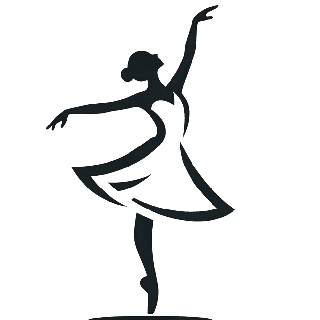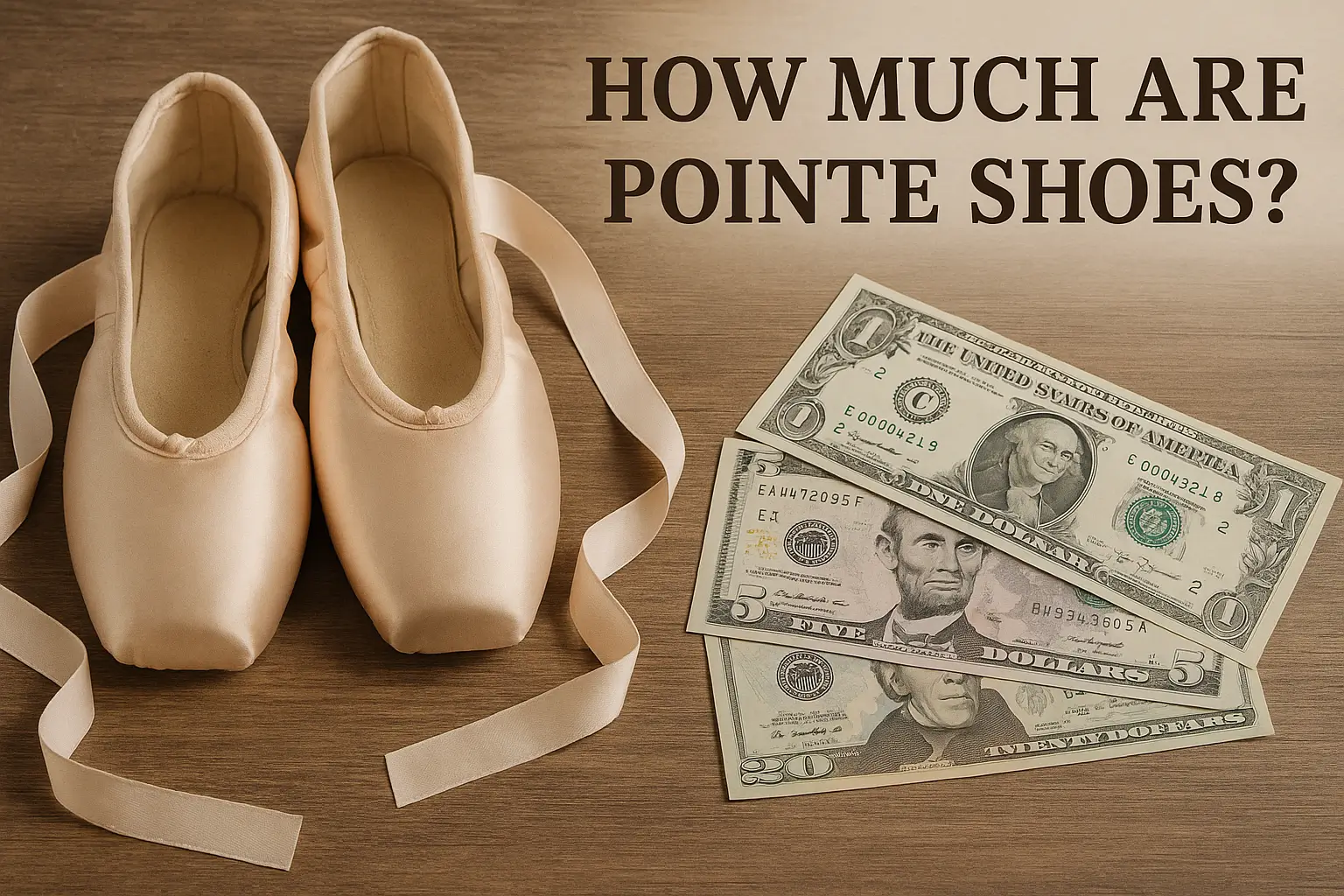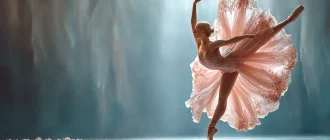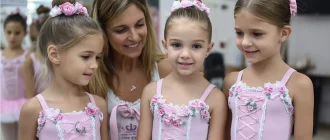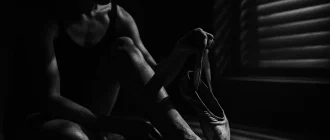Pointe shoes usually cost between $65 and $75. This article will examine the cost of pointe shoes, including the factors that influence their price, additional expenses, and budgeting tips.
Key Takeaways
- For mainstream brands, pointe shoe costs typically range from $65 to $75. Additional expenses for essential accessories and customization may increase overall expenditures.
- The average lifespan of pointe shoes is 2 to 6 weeks with regular use, resulting in significant monthly and annual costs that can reach up to $300 or $100,000 per year for professional dancers.
- Cost-saving strategies such as buying in bulk, exploring second-hand options, and proper maintenance can help dancers effectively manage the financial impact of pointe shoe expenses.
Cost of Pointe Shoes Podcast
| Brand | Approximate Price Range (USD) | Notable Features |
|---|---|---|
| Bloch | $85 – $150 | Durable materials, multiple color tones, suitable for beginners and professionals. |
| Capezio | $65 – $110 | Focus on fit and comfort, featuring a plush microfiber lining and an innovative heel design. |
| Gaynor Minden | Around $150 | High-end, customizable options, shock-absorbent foam lining, and polymer components. |
| Grishko/Nikolay | $70 – $110 | Traditional craftsmanship, various models for different foot shapes. |
| Freed of London | $50 – $110 | Handcrafted, natural materials, custom-fitted options. |
| Russian Pointe | Around $110 | Wide range of sizes and styles, pre-arched construction. |
| Suffolk | Approximately $120 | Supportive and comfortable, modern designs for contemporary feet. |
| Sansha | $45 – $75 | Affordable options, suitable for beginners, and lightweight construction. |
Note: Approximate prices may vary based on specific models, customization options, and retailers.
Breakdown of Pointe Shoe Costs
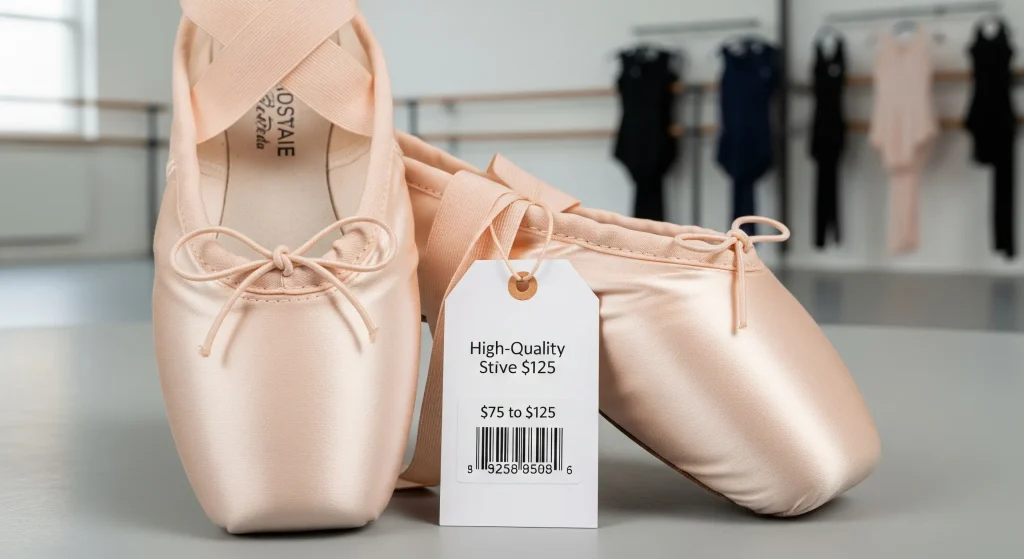
Pointe shoe costs vary widely due to factors such as brand reputation, materials, and the availability of customization options. Prices range from affordable beginner options to high-end professional shoes. Demi pointe shoes, which are softer and lack the structure of traditional pointe shoes, are a cost-effective option for beginners.
Understanding pointe shoe costs is crucial for managing a ballet budget effectively. These costs fall into three categories: the average price of new pointe shoes, additional expenses for essential accessories, and the costs of customization and handmade options. Each contributes to the overall financial commitment of dancing en pointe.
Average Cost of New Pointe Shoes
The price of new pointe shoes can vary, but most mainstream brands offer shoes within a similar range. Typically, new pointe shoes cost between $65 and $75. This price range includes well-known brands such as Gaynor Minden, So Danca, Freed, Capezio, Bloch, Grishko, and Sansha, all of which are popular choices among dancers.
The initial cost is just the beginning for beginners. As dancers progress, they may invest in various custom models and brands to find the perfect fit and support.
Additional Costs for Accessories
Beyond the cost of new pointe shoes, dancers also need essential accessories such as ribbons, elastic bands, and toe pads. These typically add around $20 to the overall expense.
The right accessories can significantly enhance a dancer’s experience. Ribbons and elastic bands secure the shoes, while the pads offer cushioning to prevent blisters, pain, and bruising.
Though seemingly minor, these additional costs are necessary investments for any serious dancer.
Customization and Handmade Options
Dancers seeking the perfect fit often prefer customized and handmade pointe shoes. Customizing the point of shoes to fit unique foot characteristics can enhance performance and comfort, but this can add up to $25 to the cost, depending on the complexity. Variations in toe length significantly impact the customization process, as different pointe shoe models offer specific attributes for toes, such as box length and vamp size, to accommodate the unique anatomical characteristics of each dancer’s feet.
Handmade pointe shoes, crafted from materials like satin and leather, offer unparalleled flexibility and support. Tailored to match the dancer’s foot shape, they provide precision that mass-produced modern pointe shoes and traditional pointe shoes may lack. Though more expensive, the benefits of a perfect fit are invaluable for serious dancers.
Lifespan of Pointe Shoes
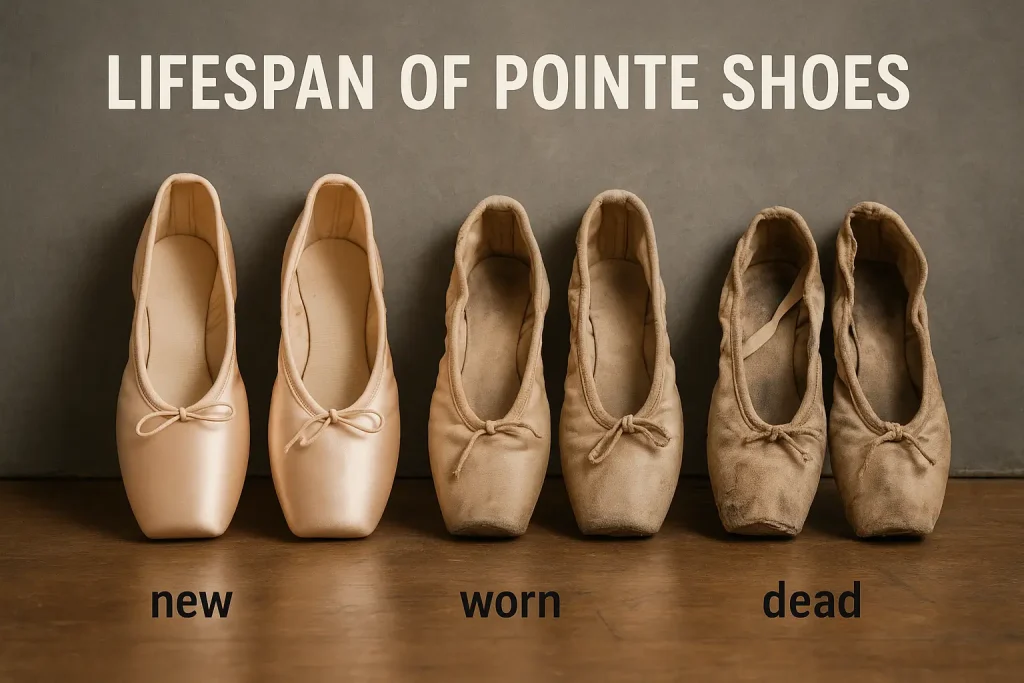
The lifespan of pointe shoes, typically 2 to 6 weeks with regular use, is crucial for understanding their overall cost. Due to the intensity of their practice, professional dancers may only use a new pair of pointe shoes for a single performance. This short lifespan means frequent investments in new pairs to maintain performance and safety standards.
Factors such as the intensity of pointe work, the dancer’s technique, and the materials used influence the longevity of pointe shoes. Understanding these can help dancers plan for replacements and manage expenses effectively.
Usage Frequency and Wear
The frequency at which a dancer uses their pointe shoes directly impacts their lifespan. Advanced ballet dancers, who spend more time en pointe, typically need more frequent replacements. The dancer’s body weight also plays a crucial role, as a heavier weight can cause the shoes to wear out faster. Professional dancers may go through approximately 500 to 800 pairs annually.
Conversely, beginners might find that their pointe shoes last six months to a year, depending on the frequency of practice and performance. Understanding personal foot usage patterns is crucial for planning replacements and preventing injuries.
Maintenance Tips for Longevity
Proper maintenance can significantly extend the life of worn pointe shoes, reducing the need for frequent replacements. Airing out pointe shoes after each use and avoiding moisture-retaining accessories, such as toe pads, can prevent material weakening and prolong the lifespan of your feet while wearing pointe shoes.
Alternating between two pairs of pointe shoes allows each fabric to dry properly and recover its shape, enhancing durability. A pointe shoe hardener can also protect the material from moisture and wear, prolonging usability.
These maintenance tips are essential for dancers seeking to optimize their investment.
Monthly and Annual Costs
Understanding the monthly and annual costs of Pointe Shoes is crucial for proper budgeting. Male dancers are also increasingly using pointe shoes, which impacts their budgeting. Frequent heel replacements can lead to spending up to $300 monthly on pointe shoes, requiring careful planning to sustain training and performances without financial strain.
Annual budgeting for pointe shoes varies significantly based on a dancer’s level and frequency of use. Professional dancers may use up to 120 pairs each season, which amounts to approximately $100,000 annually. These figures highlight the importance of planning for the required long-term financial commitment.
Monthly Expenditure Overview
On average, dancers spend around $200 per month on pointe shoes and accessories. This includes replacing shoes every 2 to 4 weeks, depending on usage and the rate of wear. Signs of needed replacement include a broken or overly soft shank and feeling the floor when en pointe, which can lead to injuries like bruised toes and toenails.
Managing these monthly expenses is crucial for dancers to ensure they have the necessary funds for training and performances. Proper budgeting and planning can help avoid unexpected financial burdens, allowing for a focus on skill improvement.
Annual Budgeting for Pointe Shoes
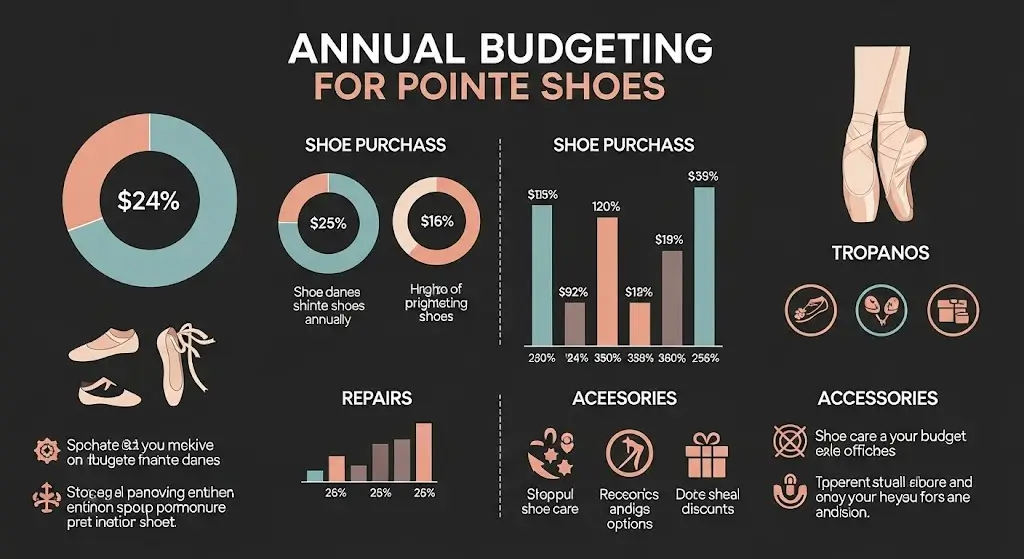
Annual spending on pointe shoes typically ranges from $2,400 to $3,600, factoring in replacements and accessories. This range accounts for the high turnover rate due to wear and tear. A well-planned budget should consider the average costs and the potential for frequent replacements, ensuring adequate funds are allocated.
For example, a company with a dancer practicing daily may find their shoes last only three weeks, while occasional users’ shoes could last up to 15 weeks. Planning for these variations in shoe lifespan is essential for accurate annual budgeting and financial management.
Cost-Saving Strategies
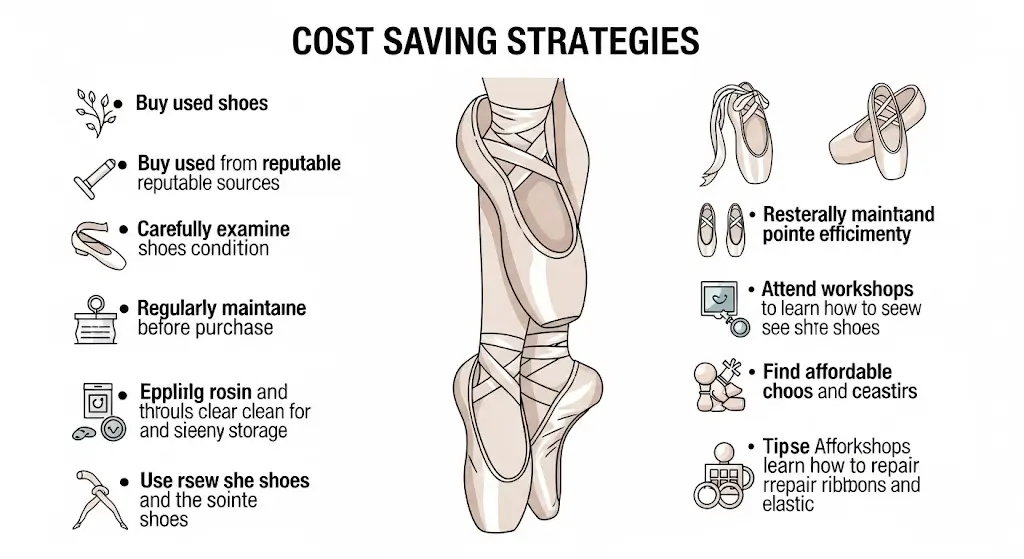
Given the significant expenses associated with pointe shoes, finding ways to save money is crucial. Implementing cost-saving strategies can help manage and pay these costs effectively, ensuring that dancers can continue their training without financial strain.
Strategies include buying in bulk, exploring second-hand and discount options, and investing in proper care and repairs. Each approach offers unique benefits and can contribute to substantial savings over time.
Buying in Bulk
Due to bulk discount prices, purchasing multiple pairs of pointe shoes simultaneously can lead to substantial savings. This reduces the cost per pair and ensures dancers have a sufficient supply for their training needs, providing peace of mind and preventing schedule disruptions.
Besides financial benefits, buying in bulk offers convenience and consistency. Dancers can maintain a consistent fit and style by purchasing the same model in larger quantities, ensuring they always have a pair that meets their needs.
Second-Hand and Discount Options
Exploring second-hand and discount options can provide affordable alternatives for dancers. These options often offer high-quality features comparable to new shoes, allowing budget-conscious dancers to maintain quality.
Second-hand pointe shoes can be found on online marketplaces, at dance schools, and through community exchanges. These options are cost-effective and flexible ways to acquire pointe shoes, ensuring necessary ankle support and optimal performance.
Proper Care and Repairs
Proper care and maintenance are essential for extending the usability of pointe shoes and minimizing replacement costs. A darning kit to reinforce the heel platform can help repair wear and prolong usability, significantly reducing replacement frequency and yielding substantial savings.
Investing time in repairs and maintenance ensures that pointe shoes provide the necessary support and performance. Proper care practices, such as airing out shoes after use and avoiding moisture retention, enhance durability and maximize lifespan.
Environmental Impact and Sustainability
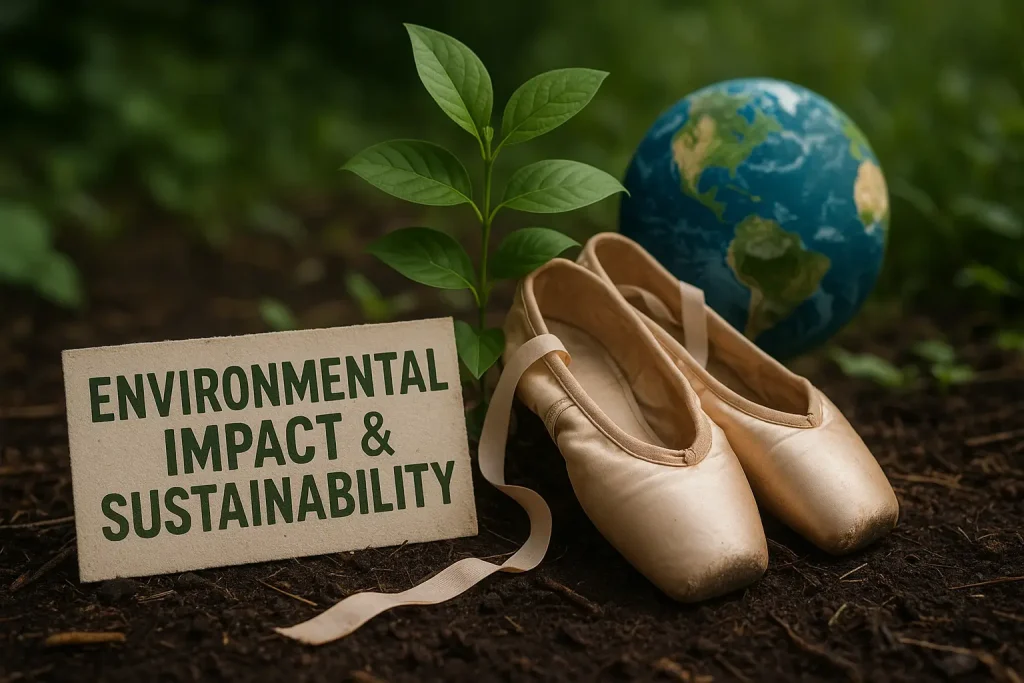
The Pointe shoe industry faces significant environmental challenges due to the use of materials and production waste. As awareness grows, initiatives and programs have emerged to address this impact by focusing on recycling and repurposing used shoes, reducing waste, and supporting sustainable practices. The design of the modern pointe shoe has evolved to include more sustainable materials, reflecting a shift towards eco-friendly practices in the industry.
Sustainability is becoming increasingly important in the ballet community, encouraging dancers and manufacturers to consider their environmental impact. Adopting eco-friendly materials and production methods can help minimize the ecological footprint of pointe shoes and contribute to a more sustainable future for ballet.
Recycling and Repurposing Pointe Shoes
Several initiatives focus on recycling and repurposing used pointe shoes to address waste. The Drop-Off Pointe initiative, for example, collects used shoes for recycling and repurposing, with some being reworked by artists. Ballet companies also advocate for recycling programs to reduce waste.
These efforts are crucial for minimizing the environmental impact of pointe shoes and promoting sustainability within the ballet and dance community. Participating in recycling programs helps dancers contribute to waste reduction and support eco-friendly practices.
Sustainable Brands and Practices
Some pointe shoe manufacturers are exploring sustainable materials, such as vegan leather alternatives, to reduce the environmental impact of production. Brands like Aera use vegan materials and are certified B-Corp companies, promoting eco-friendly practices. Piferi creates shoes using recycled PET and bio-based materials, ensuring a sustainable approach.
Efforts to adopt sustainable practices are becoming increasingly important in the production of pointe shoes. As environmental concerns rise, the ballet community is encouraged to support brands and practices that prioritize sustainability and minimize their ecological footprint.
Resume
Understanding the full spectrum of costs associated with pointe shoes is crucial for dancers at all levels. The financial commitment can be significant, ranging from the initial purchase of new pointe shoes, which typically cost between $65 and $75, to additional expenses for accessories and customization. The lifespan of pointe shoes, influenced by usage frequency and maintenance practices, further adds to the ongoing costs. Proper monthly and annual budgeting is crucial for managing these expenses effectively.
Cost-saving strategies, such as buying in bulk, exploring second-hand options, and investing in proper care and repairs, can significantly reduce the financial burden. Additionally, the ballet community is increasingly recognizing the importance of sustainability, with initiatives focusing on recycling and repurposing used pointe shoes and brands adopting eco-friendly practices. By being well-informed and proactive, dancers can manage their pointe shoe expenses and contribute to the movement toward a more sustainable ballet industry.
Frequently Asked Questions
How much do new pointe shoes typically cost?
New pointe shoes from mainstream brands typically cost between $65 and $75. However, it is advisable to consider additional costs for custom fittings and accessories.
What additional costs should I expect when buying pointe shoes?
When purchasing pointe shoes, you should anticipate additional costs of around $20 for essential accessories such as ribbons, elastic bands, and toe pads. These ensure proper fitting and comfort in the insole, which is crucial for performance.
How often do pointe shoes need to be replaced?
Pointe shoes should be replaced every 2 to 6 weeks, depending on the dancer’s skill level and the frequency of use. The condition of the toe boxes must be checked to determine when they need to be replaced. Regular assessment of their condition is essential for maintaining performance and safety.
Are there cost-saving strategies for buying pointe shoes?
Buying in bulk, exploring second-hand options, and investing in proper care and repairs are effective strategies for reducing costs when purchasing pointe shoes. Implementing these methods can significantly alleviate financial pressure.
What are some sustainable practices in the pointe shoe industry?
Sustainable practices in the pointe shoe industry include the use of eco-friendly materials, such as vegan leather alternatives and recycled PET, alongside initiatives to recycle and repurpose used pointe shoes. This commitment to sustainability reflects a growing awareness and responsibility within the industry.
How can I tell if my feet and ankles are strong enough to begin pointe work?
Before starting pointe, a qualified ballet teacher or physical therapist will assess your ankle stability, core strength, turnout control, and ability to maintain proper alignment while doing simple relevés on demi-pointe. If you can rise slowly with straight knees, hold balance without wobbling, and lower with control, you’re usually ready to start the transition.
Are there vegan or cruelty-free pointe shoes?
Yes. Several brands now offer models made without animal-derived glue or leather. They substitute synthetic adhesives, microfiber lining, and non-shellac shanks, giving dancers an option that aligns with plant-based or cruelty-free lifestyles.
Do pointe shoes come in skin-tone shades for dancers of color?
An increasing number of makers produce satin in a spectrum of browns and tans, eliminating the need to “pancake” shoes with foundation. Check the shade chart when ordering or ask your fitter to dye stock shoes to match your tights.
How do I extend the life of my pointe shoes between classes?
Rotate two or more pairs, remove toe pads to let the box dry, and store shoes open to air—never in a sealed bag. Using a mesh pouch with cedar inserts can help wick away sweat and slow down softening.
Is it safe to buy pointe shoes online without an in-person fitting?
For a first pair, no. A hands-on fitting ensures the vamp length, box width, and shank strength match your foot. Once you have a confirmed model and size, many dancers reorder online, but periodic professional refits are still essential as feet and technique evolve.
What’s the difference between traditional paste boxes and modern thermoplastic boxes?
Traditional boxes rely on layers of burlap, paper, and paste that mold to the foot but break down quickly with moisture. Thermoplastic boxes keep their shape far longer and don’t need to be “broken in,” but they feel stiffer out of the box and require precise sizing.
Can adult beginners realistically learn to dance on pointe?
Absolutely—provided they have solid foundational technique, adequate calf and intrinsic foot strength, and no contraindicating medical issues. Adults often progress more slowly than teenagers, but patience and cross-training can yield safe and satisfying results.
Why do some professionals wear two different brands during the same performance?
Dancers sometimes switch brands—or stiffness levels—between repertoire. A softer shank may suit lyrical adagio, while a firmer shank offers support for fast allegro or jumps.
Are there pointe shoe subscription services?
Yes. Specialty retailers now offer monthly or quarterly plans that ship replacement pairs on a schedule you set, often at a slight discount and with sewing supplies included.
How can I tell when a pair should be retired?
If the platform no longer feels solid, the shank snaps or folds under the arch, or you can’t maintain balance without “rolling,” it’s time to retire the pair—even if the satin still looks presentable.
Are pointe shoes tax-deductible for professional dancers?
In the United States, pointe shoes qualify as an “ordinary and necessary” business expense. Keep receipts and consult a tax professional to claim them under Schedule C or the appropriate form for your situation.
What padding options exist besides traditional gel toe pads?
Dancers experiment with lamb’s wool, silicone sheets, cotton toe socks, and even custom-molded inserts. The goal is to protect toes without deadening floor feel or adding bulk that alters fit.
Can pointe shoes be recycled or up-cycled?
While composite materials are challenging to recycle industrially, many studios repurpose discarded shoes for décor, craft projects, or educational displays. Some eco-minded companies are piloting take-back programs to reclaim steel and metals.
What’s the best way to travel with pointe shoes?
Pack them in a breathable bag, never a plastic one. If you’re flying, keep your shoes in carry-on luggage so extreme temperatures in the cargo hold don’t warp the shanks or melt glue.
Do any insurance plans cover the costs of pointe shoes for students?
Standard health insurance rarely pays for dancewear, but some private dance schools include a shoe stipend in tuition, and certain grant programs reimburse expenses for pre-professional students with documented financial need.
Are there pointe shoes designed specifically for hyper-extended knees or unusually high arches?
Yes. Makers offer models with reinforced wings, U-shaped vamps, or pre-arched shanks that help control extreme flexibility and support proper alignment.
Why might a dancer request custom-made pointe shoes?
Custom orders fine-tune box taper, shank strength, heel height, and vamp length beyond stock options, solving persistent fit issues and enhancing performance consistency, especially valuable for principal dancers with demanding touring schedules.
How does humidity affect the durability of pointe shoes?
Moisture accelerates the breakdown of paste-box shoes. Dancing in a humid climate or on a raked stage that traps sweat can cut a shoe’s lifespan in half, so extra drying time and rotation become even more critical.
